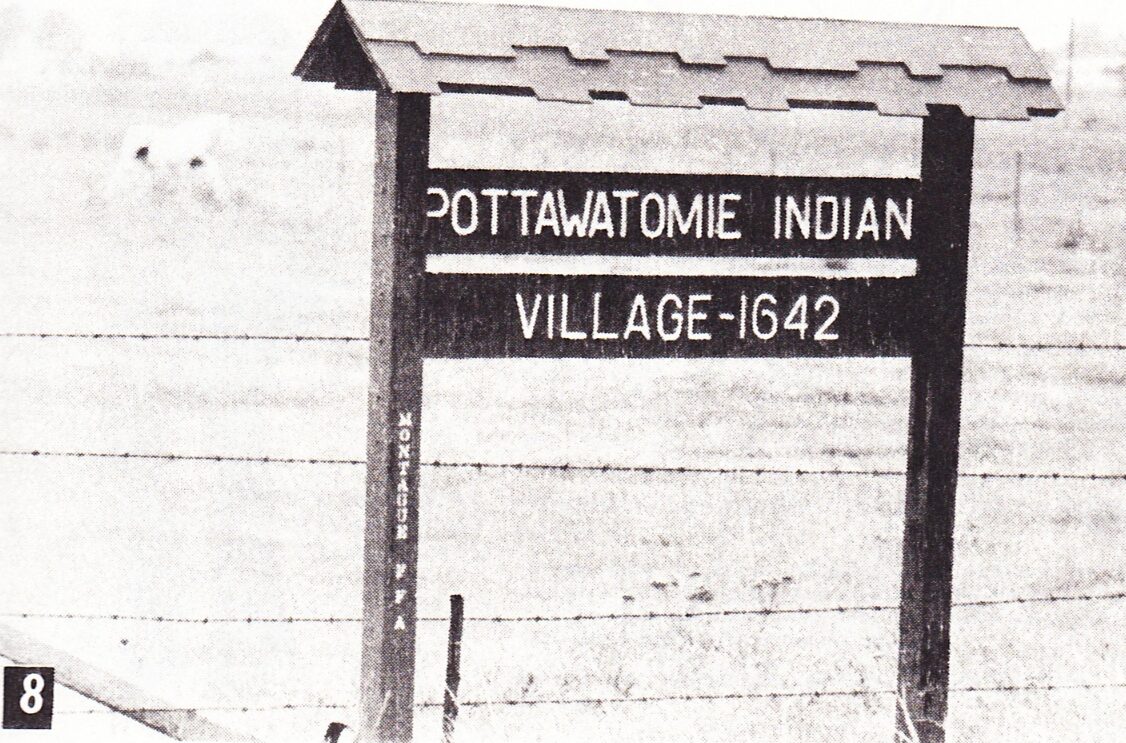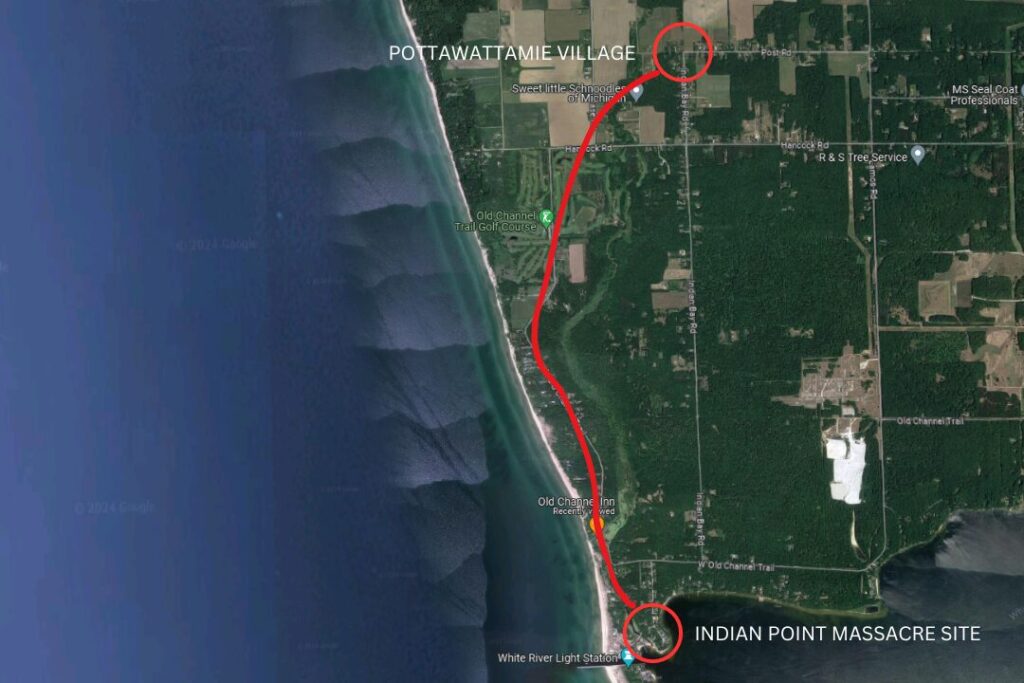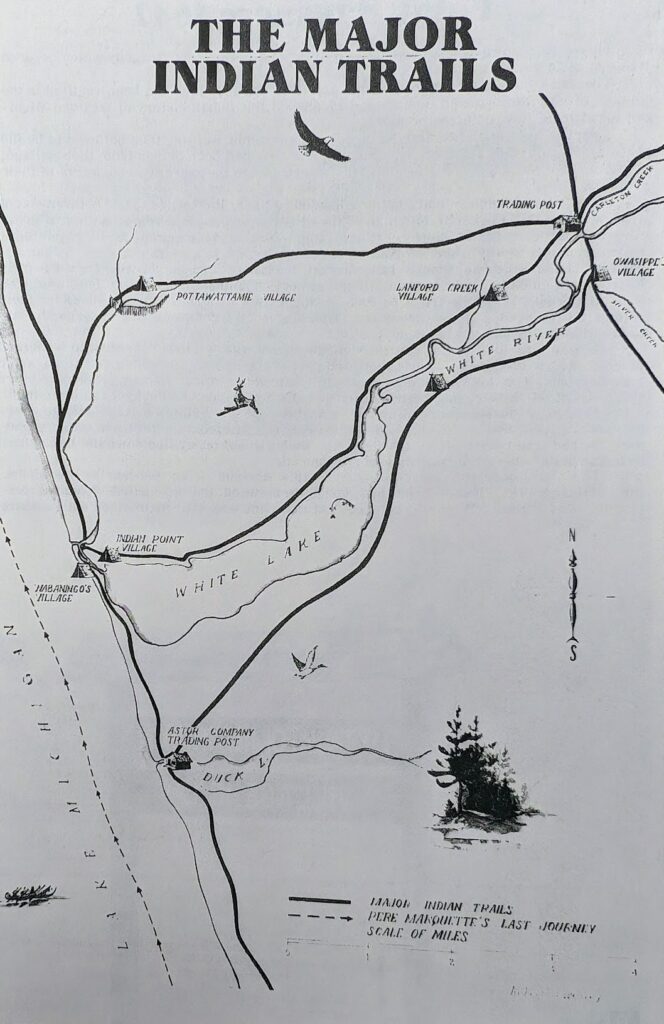
Nestled in the rich historical tapestry of Western Michigan, the story of the Indian Point Massacre of 1642 is a somber reminder of the tumultuous times faced by the indigenous Pottawatomi people. This event, steeped in local legend and verified by the Smithsonian Institute, has profoundly shaped the region’s history.
The Pottawatomi Village and the Siege of 1642
According to the legend, an aged Pottawatomi woman, believed to be around 100 years old, recounted the harrowing tale of her people’s displacement from their village on Indian Point. Nearly two centuries ago, this palisaded village was located on what is now the Cockerill Farm in White River township, a remarkable pine grove spanning over 20 acres. The village’s strategic location and the unique growth patterns of the trees suggest a deliberate effort to create a defensive barrier against their enemies.
In the summer of 1642, a force of approximately 2,000 warriors from the Nation du Feu besieged the Pottawatomi village. The attack was intense and relentless, with around 900 to 1,000 warriors defending their home. Despite their fierce resistance, the Pottawatomi’s water supply was cut off, and after ten days, the village was overrun.
The Aftermath of the Indian Point Massacre
The attackers showed no mercy; many defenders were killed on the spot, while others were captured, tortured, and executed. The survivors, including women and children, were forced to flee their homes. The Pottawatomi fled down the Indian trail to Indian Point, where the final massacre occurred, marking the end of a significant chapter in their history.

The Pottawatomi’s Journey and Resilience
From early French Jesuit accounts, such as the Relation for 1644, we learn that the Neutral Indians, a tribe that did not engage in warfare against the English and maintained neutrality, were also involved in these turbulent times. However, the Pottawatomi people faced continuous pressure from various tribes, including the Neuters and Ottawas, leading to their displacement from Southeastern and Central Michigan.
Despite the onslaught and the ensuing hardships, the Pottawatomi displayed remarkable resilience. After being driven from their ancestral lands, they sought refuge in Wisconsin, only to return years later. However, they were eventually pushed into Southern Michigan and Illinois by the Ottawa tribe in the early 19th century.
Indian Point Massacre Site: A Place of Remembrance
Today, Indian Point stands as a poignant reminder of the Pottawatomi’s struggles and perseverance. The area, located on the North Shore of White Lake overlooking Lake Michigan, has revealed numerous Indian graves, bearing silent witness to the tragic events of 1642. These graves, along with other archaeological findings, provide invaluable insights into the lives and deaths of those who once called this land their home.
The Legacy of the Pottawatomi
By the late 18th century, the Pottawatomi people were recognized as Michigan’s first farmers. They built palisaded villages, crafted intricate tools and pottery, and engaged in various cultural practices that highlighted their rich heritage. Despite the adversities they faced, the Pottawatomi’s legacy of resilience and adaptability continues to be a vital part of Michigan’s history.
In conclusion, the Indian Point Massacre of 1642 is more than just a historical event; it is a testament to the enduring spirit of the Pottawatomi people. As we reflect on this tragic chapter, we honor their memory and acknowledge the profound impact they have had on the region’s cultural and historical landscape.

Interactive White Lake History
We were not able to locate the present day location of the historical marker referenced in this article. Any information regarding this marker would be appreciated.
As we deliver articles weekly, I challenge you to be curious, explore the local area, and take pictures at these historic locations, and tag CatchMark Community.
Next week we will explore Thomas Hubbard and his namesake cemetery. If you enjoy history and like our content please like and subscribe to our online resources. Also, check out the White Lake Area Historical Society website listed below.
http://www.whitelakeareahistoricalsociety.com/
https://www.facebook.com/CatchMarkCommunity
Brent is the Managing Partner of CatchMark Technologies and a seasoned technologist with over 25 years of experience in IT leadership, cybersecurity, and technical operations. He began his career serving in the U.S. Army, where he worked extensively with electronics—laying the foundation for his lifelong passion for technology and problem-solving. Brent holds a Certified Information Systems Security Professional (CISSP) certification and currently leads CatchMark’s Cybersecurity and Tech Support teams. Known for his strategic thinking and hands-on expertise, he excels in guiding secure, scalable solutions and driving innovation across complex technical environments.
Must See
-


Community
/ 13 hours agoMontague-Whitehall Rotary Club Donates $2,500 to Support Clean Water in Haiti Through HANWASH
By investing in clean water, a basic human right, the Montague-Whitehall Rotary Club is...
By Brent Raeth -


Community
/ 3 days agoPetunia Patrol: Keeping White Lake Beautiful
Each summer, the streets of Montague and Whitehall burst into color, lined with lush,...
By Amy Yonkman -


Arts/Entertainment
/ 3 days agoWhite Lake Area Live Music Lineup: June 2–8, 2025
Eight Whitehall and Montague venues are bringing the music this week, with 21 live...
By Amy Yonkman












